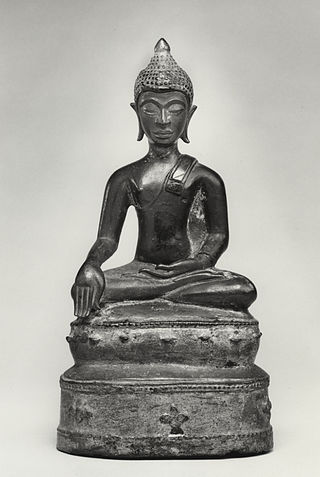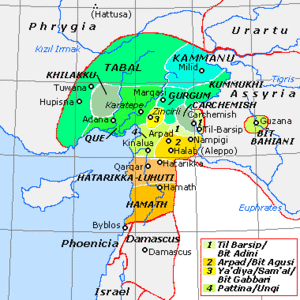
The Bronze Age is a historic period, lasting from approximately 3300 BC to 1200 BC. It is characterized by the use of bronze, the use of writing in some areas, and other features of early urban civilization. The Bronze Age is the middle principal period of the three-age system, between the Stone and Iron Ages. This system was proposed in 1836 by Christian Jürgensen Thomsen for classifying and studying ancient societies and history. Worldwide, the Bronze Age generally followed the Neolithic period, with the Chalcolithic serving as a transition.

The Hurrians were a people who inhabited the Ancient Near East during the Bronze Age. They spoke the Hurrian language, and lived throughout northern Syria, upper Mesopotamia and southeastern Anatolia.

Mitanni, earlier called Ḫabigalbat in old Babylonian texts, c. 1600 BC; Hanigalbat or Hani-Rabbat in Assyrian records, or Naharin in Egyptian texts, was a Hurrian-speaking state in northern Syria and southeast Anatolia with Indo-Aryan linguistic and political influences. Since no histories, royal annals or chronicles have yet been found in its excavated sites, knowledge about Mitanni is sparse compared to the other powers in the area, and dependent on what its neighbours commented in their texts.

Carchemish, also spelled Karkemish, was an important ancient capital in the northern part of the region of Syria. At times during its history the city was independent, but it was also part of the Mitanni, Hittite and Neo-Assyrian Empires. Today it is on the frontier between Turkey and Syria.

Washukanni was the capital of the Hurrian kingdom of Mitanni, from around 1500 BC to the 13th century BC.

The Kura–Araxes culture was an archaeological culture that existed from about 4000 BC until about 2000 BC, which has traditionally been regarded as the date of its end; in some locations it may have disappeared as early as 2600 or 2700 BC. The earliest evidence for this culture is found on the Ararat plain; it spread north in the Caucasus by 3000 BC.

Malatya is a city in the Eastern Anatolia region of Turkey and the capital of Malatya Province. The city has been a human settlement for thousands of years.

Bronze Age swords appeared from around the 17th century BC, in the Black Sea and Aegean regions, as a further development of the dagger. They were replaced by iron swords during the early part of the 1st millennium BC.

Shaushtatar was a king of the Hurrian kingdom of Mitanni in the fifteenth century BC. Two tablets of Shaushtatar, legal decisions, were found at Alalakh. They mention Niqmepa, the king of Alalakh, providing a synchronism. A tablet of Shaushtatar was found at Tall Bazi, granting land.
Isuwa, was a kingdom founded by the Hurrians, which came under Hittite sovereignty towards 1600 BC as a result of their struggle with the Hittites.

The Museum of Anatolian Civilizations is located on the south side of Ankara Castle in the Atpazarı area in Ankara, Turkey. It consists of the old Ottoman Mahmut Paşa bazaar storage building, and the Kurşunlu Han. Because of Atatürk's desire to establish a Hittite museum, the buildings were bought upon the suggestion of Hamit Zübeyir Koşay, who was then Culture Minister, to the National Education Minister, Saffet Arıkan. After the remodelling and repairs were completed (1938–1968), the building was opened to the public as the Ankara Archaeological Museum.

Arsenical bronze is an alloy in which arsenic, as opposed to or in addition to tin or other constituent metals, is combined with copper to make bronze. The use of arsenic with copper, either as the secondary constituent or with another component such as tin, results in a stronger final product and better casting behavior.

Alacahöyük or Alaca Höyük is the site of a Neolithic and Hittite settlement and is an important archaeological site. It is situated near the village of Alacahüyük in the Alaca District of Çorum Province, Turkey, northeast of Boğazkale, where the ancient capital city Hattusa of the Hittite Empire was situated. Its Hittite name is unknown: connections with Arinna, Tawiniya, and Zippalanda have all been suggested.
The Luwians were an ancient people in Anatolia who spoke the Luwian language. During the Bronze Age, Luwians formed part of the population of the Hittite Empire and adjoining states such as Kizzuwatna. During the Hittite New Kingdom, Luwian replaced Hittite as the empire's dominant language. In the early Iron Age, a number of Luwian-speaking Neo-Hittite states arose in northern Syria. The Luwians are known largely from their language, and it is unclear to what extent they formed a unified cultural or political group.
Soyuqbulaq is a village in the Agstafa Rayon of Azerbaijan. It forms part of the municipality of Köçvəlili.

The ancient Near East was the home of early civilizations within a region roughly corresponding to the modern Middle East: Mesopotamia, ancient Egypt, ancient Persia, Anatolia and the Armenian highlands, the Levant and the Arabian Peninsula. The ancient Near East is studied in the fields of ancient Near East studies, Near Eastern archaeology, and ancient history.

The Leyla-Tepe culture of the South Caucasus belongs to the Chalcolithic era. It got its name from the site in the Agdam District of modern-day Azerbaijan. Its settlements were distributed on the southern slopes of Central Caucasus, from 4350 until 4000 B.C.

The Birecik Dam Cemetery is an Early Bronze Age cemetery in the Gaziantep region in southeastern Turkey. This cemetery was used extensively for a very short period of time at the beginning of the third millennium BC.

Malatya Museum is a museum in Malatya, Turkey
Değirmentepe or Değirmentepe Hüyük is an archaeological site which is located at 50 km north of the river Euphrates and at 24 km in the northeast of Malatya province in eastern Anatolia. It is now submerged in the reservoir area of the Karakaya and Atatürk dams. Rescue excavations were undertaken in 1978 under the supervision of Ufuk Esin of Istanbul University and interrupted in 1989 by flooding of the dams.



























